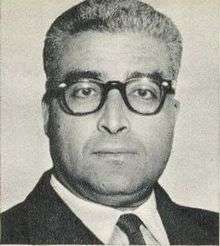Bahi Ladgham
Bahi Ladgham (10 January 1913 – 13 April 1998) (Tunisian Arabic: الباهي الادغم ) was a Tunisian politician.
- Secretary of Presidency (1957–1969) (de facto prime minister).
- Prime minister of Tunisia (7 November 1969 – 2 November 1970)
Bahi Ladgham الباهي الأدغم | |
|---|---|
 | |
| 1st Prime Minister of Tunisia | |
| In office 7 November 1969 – 2 November 1970 | |
| Preceded by | Office Established Habib Bourguiba, 1957 |
| Succeeded by | Hédi Nouira |
| Personal details | |
| Born | 10 January 1913 Tunis, French Tunisia[1] |
| Died | 13 April 1998 (aged 85) Paris, Île-de-France French Republic |
Biography
He is the son of Ahmed Ladgham, himself the son of a Libyan immigrant from Misrata to settle in Tunisia in the mid-nineteenth century because of a local revolt against the Ottoman presence, and a Tunisian woman the Kachoukh family of the Sahel, Zohra Ben Aouda, daughter of Algerian immigrants from Medea who fled the French repression of supporters of Emir Abd el-Kader; she dies when he is only eight and a half.
Coming from a modest family living in the Tunisian district of Bab El Akouas, Bahi Ladgham lives in a cultural atmosphere where Tunisians of different origins mix. He studied at the kouttab of his neighborhood before entering Sadiki College in 1921 at the age of eight, on the advice of a friend of his father, Hassen Chadli. Brilliant throughout his studies, he received several awards and congratulations from his teachers, including Mohamed Tahar Ben Achour and Mohamed Salah Mzali.
After the First World War, the backroom of his father is a place for debate and discussion around political and cultural themes: the fall of the Ottoman Empire, the de-Islamization of Turkey by Mustafa Kemal Atatürk, the struggle of Libyan nationalists against Italy but especially the situation of Tunisia with the foundation of Destour by Abdelaziz Thâalbi in 1920.
Also an adept reader, this context leads him to want to revolt against the French occupier.
References
- The International Who's Who, 1997-98. Europa Publications. 1997. ISBN 9781857430226. Retrieved 2015-04-08.
